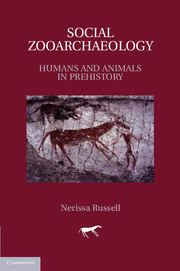Book contents
- Frontmatter
- Contents
- List of tables
- Preface
- 1 Beyond protein and calories
- 2 Animal symbols
- 3 Animals in ritual
- 4 Hunting and humanity
- 5 Extinctions
- 6 Domestication as a human–animal relationship
- 7 Pets and other human–animal relationships
- 8 Animal wealth
- 9 Meat beyond diet
- 10 Studying human–animal relations
- References
- Index
5 - Extinctions
Published online by Cambridge University Press: 05 June 2012
- Frontmatter
- Contents
- List of tables
- Preface
- 1 Beyond protein and calories
- 2 Animal symbols
- 3 Animals in ritual
- 4 Hunting and humanity
- 5 Extinctions
- 6 Domestication as a human–animal relationship
- 7 Pets and other human–animal relationships
- 8 Animal wealth
- 9 Meat beyond diet
- 10 Studying human–animal relations
- References
- Index
Summary
The account of the ways along which this animal world has gradually succumbed to our species would involve the whole history of civilization.…By and by they turned the artillery of Nature on herself. The dog raised a flag of truce and came in to join the hosts of man against the rest. The mountain sheep and the wild goat descended from their rocky fortresses, gave up the contest, and surrendered skins and fleece and flesh and milk to clothe and feed the inventor of the fatal arrow.…Those that refused to enter in any way into these stipulations are doomed sooner or later to extinction, and many species have already disappeared or withdrawn to the waste places of earth in despair. (Mason 1966[1895]:259–60)
Driving animal species into extinction may be the most brutal kind of human–animal relationship. People have been responsible for the disappearance of many animal species, most of them in the last two hundred years. In this chapter we are concerned with prehistoric extinctions and the role that humans may have played in them. We can take some lessons from more recent extinctions. The anthropogenic factors that can contribute to animal extinctions include overhunting or persecution, pollution, the introduction of exotic predators or competitors, and habitat destruction (Eldredge 1999; Halliday 1978; MacPhee and Flemming 1999). In general, habitat destruction is the most insidious (Fuller 2001). All of these factors are exacerbated by human population growth.
Island extinctions
The clearest evidence for humanly caused prehistoric animal extinctions comes from islands around the world. Islands are often described as natural laboratories that act as models for mainland areas or for the earth as a whole (Halliday 1978:170; Kirch 1997). Although it may be useful to view the earth itself as an island, we should be cautious in drawing analogies between island events and those on the mainland (Walter 2004). As outlined in the theory of island biogeography (MacArthur and Wilson 1967), the bounded, small-scale ecosystems of islands are particularly fragile. Not only are there fewer opportunities for restocking from other regions but island floras and faunas also are typically impoverished in their number of species, creating simpler and more vulnerable ecosystems. Where islands lack large predators, animals lose their bodily and behavioral defense mechanisms. This is frequently the case because the small landmass of islands does not provide territories of sufficient size for larger predators. For similar reasons, large herbivores on islands often become dwarfed. In contrast, small animals may become larger to avoid the small predators that remain. Island animals that care for their young tend to develop lower birth rates, because the population is limited not by predation but by the availability of food (Alcover et al. 1998; Schüle 1993:403). This vulnerability has led to high rates of extinctions following human contact. At least 27% of all mammals or 35% of nonflying mammals and more than 60% of bird species have been lost from islands worldwide; mammals weighing more than 5 kg are more likely to become extinct than smaller ones (Alcover et al. 1998).
- Type
- Chapter
- Information
- Social ZooarchaeologyHumans and Animals in Prehistory, pp. 176 - 206Publisher: Cambridge University PressPrint publication year: 2011



